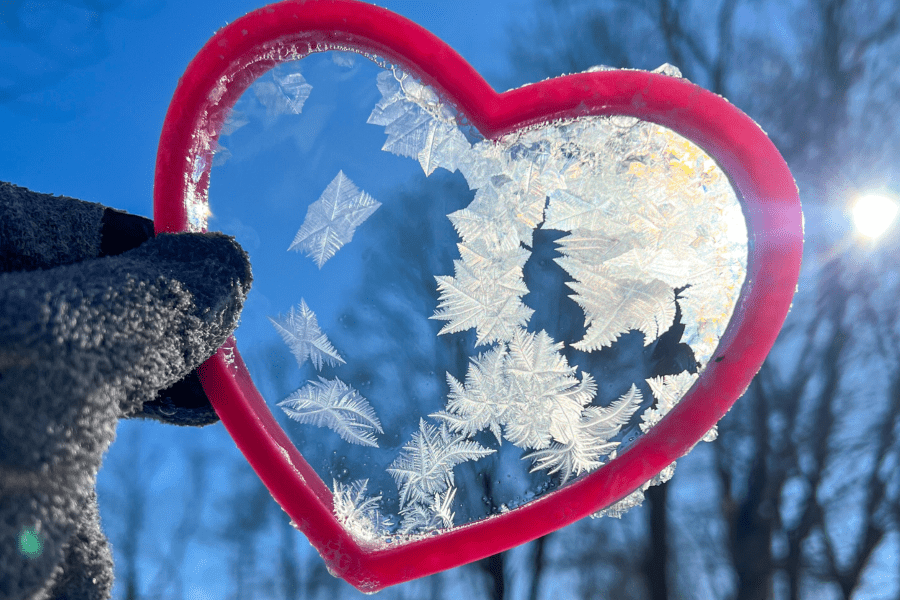
How to Make Frozen Bubbles in Winter
|
|
There’s something truly magical about winter—snow-covered landscapes, frosty windows, and those crisp, cold mornings. One of my favorite winter science activities we’ve done this season is our Frozen Bubbles Experiment! This simple yet mesmerizing experiment is a great way to bring science magic to your homeschool day.
So, grab your coats, mix up our special bubble recipe, and let’s dive into one of the coolest (literally!) winter science experiments you can do with your kids.
This frozen bubble experiment is easy to set up, and you probably have everything you need in your kitchen right now. The key to making bubbles that freeze beautifully is using the right solution. The secret? A little sugar and corn syrup! These ingredients help the bubbles last longer in the frigid air, giving them time to crystallize.
Here’s what we used:
Simply mix everything together in a shallow container, dissolving the sugar as much as possible. We found that warm water helps everything blend better!
We originally planned to blow bubbles and watch them freeze , but there was just enough breeze to make that almost impossible. Every time we tried catching them, they floated away or popped before we could see the magic happen!
So, we switched things up—and it was just as aewsome!
The best part? We didn’t have to chase bubbles around or worry about them popping too soon. The soap film inside the cookie cutter froze beautifully, and we got to observe every detail up close!
We tried heart cookie cutters since we're in Valentine's Day mode, but any shape should work ... your cookie cutter will turn into a delicate ice window with intricate frost patterns. The way the ice crystals spread across the surface was absolutely mesmerizing!
One of the most fascinating parts of this winter science experiment can be seeing how frozen bubbles break apart.
One of my homeschool mom friends did this experiment on the same day. She had less wind at her house and they were able to actually blow and catch bubbles. She said when they touched or tapped it, the entire thing shattered into tiny icy shards, almost like delicate glass breaking. SO COOL!
So, what exactly is happening when bubbles freeze? This is where the science magic comes in!
1. How Do Bubbles Form?
Bubbles are thin layers of soapy water that trap air inside. The dish soap helps the bubble stretch without popping too quickly, while the sugar and corn syrup in our recipe help slow down evaporation—giving the bubble time to freeze.
2. How Do Bubbles Freeze?
When the temperature outside is below freezing, the water molecules in the bubble film start to slow down and crystallize. Instead of evaporating like they would on a warm day, they turn into ice crystals that spread across the bubble’s surface.
3. Why Do Some Bubbles Shatter?
Frozen bubbles don’t last long! The air inside contracts as it cools, making the bubble shrink and collapse. Eventually, the delicate ice layer becomes too thin, and the bubble shatters like glass.
If your kids love this winter science experiment, here are some fun ways to take it even further:
Frozen bubbles are stunning when photographed up close! If you have a macro lens or a phone with a good camera, try capturing the frost patterns as they form.
Have your kids draw or describe what they see happening to the bubbles in their science journal. Encourage them to make predictions before each experiment!
Does a frozen bubble last longer on snow, ice, metal, or glass? Try different surfaces and see what happens!
Our frozen bubbles experiment was such a fun way to spend a winter afternoon! Not only did my kids love watching the bubbles freeze, change, and shatter, but they also learned about temperature, ice formation, and the science of bubbles in a hands-on way.
If you’re looking for fun winter activities that blend science and play, this is a must-try! Whether you’re using cookie cutters for frozen shapes or watching bubbles shatter in the air, this winter science activity will leave your kids in awe. Have some frosty fun!




